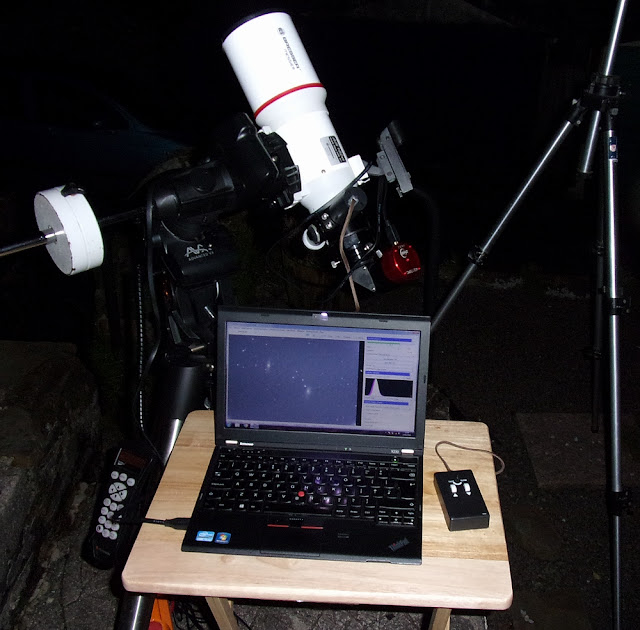This is not a re-write from scratch, it is a port of the Linux version to Windows, although a large amount of re-factoring of the code is required because of the substantial differences between the two platforms. It is a work in progress but first astronomical light has been achieved with both Windows 10 and Windows 7. It was decided to test on a Windows 7 machine as well as a Windows 10 machine because at the moment it seems that there are still huge numbers of people who are keeping Win 7, and not upgrading to Win 10. The reasons for this could be manifold, but one reason is that astronomers may well have their astronomy software running well on Win 7, and they don’t want to risk some of it not running as expected in Win 10.
Windows 7 testing of AstroDMx Capture for Windows on Deep Sky imaging
A Bresser AR 102xs f/4.5 ED refractor was mounted on a Celestron AVX, GOTO mount. A ZWO ASI 178MC 14-bit camera, fitted with an SVBONY UV/IR cut filter was placed at the prime focus.
The equipment setup
The three galaxies of the Leo triplet were imaged with 30 x 80s, 16-bit exposures with matching dark-frames, in two separate frames. M65 and M66 were captured in one frame and NGC3628, the Hamburger galaxy was imaged in the other. Deep Sky Stacker was used to stack the images. The Gimp 2.10 and Neat Image were used to post-process the images.
The globular cluster M3 was imaged with 30 x 30s, 16-bit exposures with matching dark-frames. Deep Sky Stacker was used to stack the images. The Gimp 2.10 and FastStone was used to post-process the images.
Screenshot of AstroDMx Capture for Windows capturing data on M3 in Win 7
M3
Screenshot of AstroDMx Capture for Windows capturing data on NGC 3628 in Win 7
NGC 3628, The Hamburger galaxy
Screenshot of AstroDMx Capture for Linux capturing data on M65 and M66 in Win7
M65 and M66
Windows 10 testing of AstroDMx Capture for Windows on the Moon
A QHY5L-II-M camera was placed at the Cassegrain focus of a Skymax 127 Maksutov, mounted on a Celestron AVX, GOTO mount. 1500-frame SER files were capture of various regions of the 91.5% waning, gibbous Moon at 30fps.
The best 90% of the frames in the SER files were stacked in Autostakkert! 3.0. The resulting images were wavelet processed in Registax 5.1 and post processed in the Gimp 2.10.
Screenshot of AstroDMx Capture for Windows capturing data on the Janssen region of the Moon in Win10
Janssen, Fabricus, Metius, Brenner region of the Moon
Screenshot of AstroDMx Capture for Windows capturing data on the Tycho region in Win 10
Tycho region of the 91.5% waning Moon
I shall report any further progress with AstroDMx Capture for Windows.











